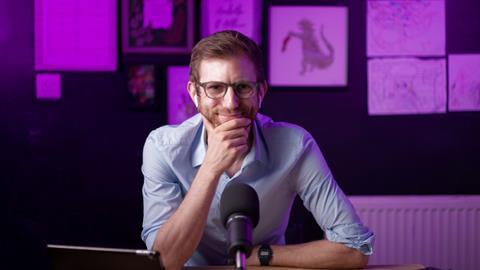Dominic Danson, founder and director of Twelve Noon Films, looks at how companies can navigate choppy waters

If you’ve spent any time near the world of production and post-production lately, you’ll know just how bruised and battered it feels. In conversations with Victor Perez, a VFX supervisor with credits on everything from Harry Potter to Pirates of the Caribbean, and veteran VFX producer, Will Cohen, the same frustrations repeat like a grim chorus: unsustainable financial pressures, a production environment still limping from COVID’s aftershocks, and an industry-wide contraction that has left artists, producers, and studios exhausted.
Add to that the looming, often misunderstood spectre of artificial intelligence, and it’s no wonder the entire ecosystem feels under siege. But these pressures might just be the catalyst for change we desperately need. The answer isn’t to double down on bigger, slower, risk-averse behemoths that treat storytelling like an investment bank treats quarterly returns. Instead, the solution may lie with smaller, more agile, creatively led studios that can spread risk, move faster, and put the story – rather than the spreadsheet – back at the heart of filmmaking.
Threats and benefits
Just as the camera didn’t kill painting but, instead, forced artists to focus on meaning over technique, AI could force our industry to ask harder questions about why we create in the first place. Machines can handle more and more, but let human artists lean fully into their one true advantage: ideas. Smaller studios, unencumbered by legacy pipelines and outdated business practices, are best placed to do exactly that.
And what about the risk? This is where a distributed ecosystem is so valuable. When you have hundreds of independent studios, then adopting new technologies becomes easier and the danger of one catastrophic collapse is dramatically reduced. Smaller outfits can test, iterate, and learn far faster than the monolithic structures of old. It means the risk is spread, while the benefits – creative and financial – can be scaled across a broader community of storytellers.
Cinema itself risks becoming a kind of boutique theatre: once affordable, now drifting into a luxury experience. If audiences only go twice a year, how sustainable is that for the craft of storytelling? Especially in a climate where YouTube, TikTok, and vertical “snackable” content is devouring our attention. Big tentpole franchises can no longer bank on sheer spectacle to keep bums on seats. Audiences still crave stories, and they seek out authenticity, wonder, and a good tale well told.
For story’s sake
The current culture of risk-aversion, where boardrooms cling to bankable IP and an ocean of identikit superhero spin-offs, is creatively bankrupt. Some epics do still make it through, but would the likes of Oppenheimer ever have been commissioned without the celebrity of Nolan? It’s unthinkable in a risk-managed, quarterly-focused mindset. Smaller studios, with smaller budgets and less corporate oversight, can take these chances every day without compromising on quality.
Change is always scary, but artists thrive on change. AI is just one more in a long line of tools, from film to digital cameras to virtual production. It’s an evolution. Like the paintbrush or the camera, it’s only dangerous if misused. But in the hands of artists who still care about storytelling, it can be liberating – a chance to strip away barriers and refocus on narrative, meaning, and emotion.
The real tragedy of the past decade isn’t just the layoffs or the studio bankruptcies. It’s that the entire industry seems to have lost its nerve. Once upon a time, producers would back wild, visionary stories that might fail – or might change cinema forever. Now, a culture of financial caution has stripped away that sense of adventure. And too few people look to the world of indie film.
That’s why a new breed of smaller, more dynamic studios is so important. They can share skills, experiment with the latest technology, break apart ancient pipelines, and above all, refuse to let “finance first” thinking crush the soul of their work. A distributed network of storytellers, collaborating and learning from one another, might be the most resilient and the most creatively thrilling future we can build.
New blood
There’s another upside here: a more level playing field for emerging talent. In the same way the democratisation of cameras and editing tools fuelled the YouTube revolution, a wave of smaller studios could unlock opportunities for a new generation of artists who would otherwise be locked out of a fortress-like industry. Lower barriers to entry mean more fresh voices, more diverse perspectives, and stories that haven’t yet been told.
Of course there will be pain along the way. Supply is at a level to cater for the demand of ten years ago. The industry will shrink. And it will hurt. Some studios will fall. Some artists will pivot to other sectors. But out of that painful contraction, we have a chance to build something more sustainable, more human. The show mustn’t just go on. It needs to change.
We have all the technology we could ever need. From LED volumes to AI-driven dubbing to cloud-based workflows, there’s no shortage of cutting-edge tools. But the missing ingredient is cultural: we need to rewire an industry that has become afraid of risk, addicted to scale, and strangled by its own size. We need to put storytelling – the raw, fragile, powerful thing that film and TV are supposed to be – back at the heart of every decision.
If the world of production wants to survive, let alone thrive, it can’t go back to the old ways. It must move forward, smaller, faster, bolder. Only then can we rescue the art from the accountants, and make films worth remembering.

Dominic Danson is founder and director of Twelve Noon Films






No comments yet